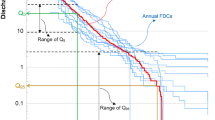Abstract
The sample Dykstra–Parsons (DP) coefficient, the most popular heterogeneity static measure among petroleum engineers, may exhibit significant sampling errors. Moreover, approximations of its probability distributions (uncertainty estimates) are only available for specific families of permeability models (e.g., log-normal). The cited probability distributions allow for the specification of confidence intervals and other inferences for the theoretical DP, which will be useful for reservoir screening purposes, or to establish if a more detailed study is justified. This paper presents the development of an asymptotic approximation of the distribution of the sample Dykstra–Parsons coefficient, which is independent of the permeability probability distribution. The effectiveness (bias and confidence intervals) of the proposed approach is demonstrated using analytical and field case studies and by comparing the results gleaned with those obtained using a well-known parametric approximation, under different scenarios of reservoir maturity levels (i.e., number of wells) and different degrees of deviation from the log-normal probability density function assumption. The results show that, in the vast majority of the case studies, the proposed approach outperformed the parametric approximation; in particular, our approach resulted in a significant reduction of the bias and the confidence intervals always including the theoretical DP coefficient. In addition, an excellent agreement was observed between the asymptotic cumulative distribution of the DP coefficient and the corresponding empirical distribution for sample sizes as small as one hundred, which suggests that high success rates can be obtained when reservoirs are classified according to the asymptotic DP coefficient.
Similar content being viewed by others
References
Adewusi V (2002) EWAN C-2/C-3 polymer flood: performance predictions. Pet Sci Technol, 20(5–6):441–463
Alajmi A, Gharbi R, Algharaib M (2009) Investigating the performance of hot water injection in geostatistically generated permeable media. J Pet Sci Eng 66(3–4):143–155
Bossie-Codreanu D, Le Gallo Y (2004) A simulation method for the rapid screening of potential depleted oil reservoirs for CO2 sequestration. Energy 29(9–10):1347–1359
Casella G, Berger RL (2002) Statistical inference. Duxbury, Scituate
Cramer H (1999) Mathematical methods of statistics. Princeton University Press, Princeton
David HA, Nagaraja HN (2003) Order statistics. Wiley, Hoboken
Dykstra H, Parsons RL (1950) The prediction of oil recovery by water flood. In: American Petroleum Institute, Secondary Recovery of Oil in the United States, 2nd edn. API, Dallas, pp 160–174
Goggin DJ, Chandeler MA, Kocurek G, Lake LW (1988) Patterns of permeability in Eolian deposits. SPE Form Eval 3(2):297–306
Jensen JL, Currie I (1988) Improving performance prediction by more accurate heterogeneity assessment. SPE 17364, presented at the SPE/DOE Enhanced Oil Recovery Symposium held in Tulsa, OK, April 17–20, 1988
Jensen JL, Currie I (1990) A new method for estimating the Dykstra-Parsons coefficient to characterize reservoir heterogeneity. SPE Reserv Eng 3(7):369–374
Jensen JL, Lake LW (1988) The influence of sample size and permeability distribution on heterogeneity measures. SPE Reserv Eng 3(2):629–637
Jensen JL, Lake LW, Hinkley DV (1987) A statistical study of reservoir permeability: distributions, correlations and averages. SPE Form Eval 2(4):461–468
Lake LW, Jensen JL (1991) A review of heterogeneity measures used in reservoir characterization. In Situ, 15(4):409–440
Lambert ME (1981) A statistical study of reservoir heterogeneity. MS Thesis, University of Texas at Austin
Lilliefors H (1967) On the Kolmogorov–Smirnov test for normality with mean and variance unknown. J Am Stat Assoc 62:399–402
Maschio C, Schiozer D (2003) A new upscaling technique based on Dykstra–Parsons coefficient: evaluation with streamline reservoir simulation. J Pet Sci Eng 40(1–2):27–36
McCoy S, Rubin E (2009) The effect of high oil prices on EOR project economics. Energy Procedia 1(1):4143–4150
Mergany M (2007) Geological and statistical reservoir characteristics of the Late Carboniferous-Permian. Masters Abstr Int 46(1)
Parzen E (1962) On estimation of a probability density function and mode. Ann Math Stat 33:1065–1076
Author information
Authors and Affiliations
Corresponding author
Rights and permissions
About this article
Cite this article
Pintos, S., Bohorquez, C. & Queipo, N.V. Asymptotic Dykstra–Parsons Distribution, Estimates and Confidence Intervals. Math Geosci 43, 329–343 (2011). https://doi.org/10.1007/s11004-011-9327-8
Received:
Accepted:
Published:
Issue Date:
DOI: https://doi.org/10.1007/s11004-011-9327-8




